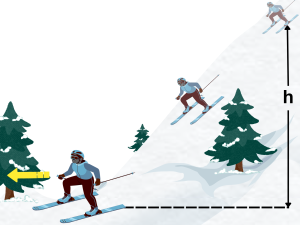10.2. Solved Examples: Work
Example 1.
How much work is done on a vacuum cleaner pulled [latex]3.0\ \text{m}[/latex] by a force of [latex]50.0\ \text{N}[/latex] at an angle of [latex]30.0[/latex] above the horizontal?
[latex]F = 50.0\ \text{N}[/latex]
[latex]d = 3.0\ \text{m}[/latex]
[latex]\theta = 30^\circ[/latex]
[latex]W = \; ?[/latex]
Solution:
[latex]W = F \times d \times \cos\theta = 50.0 \times 3.0 \times \cos 30^\circ[/latex]
[latex]W = 130\ \text{J}[/latex]
Example 2.
A worker pushes a [latex]30.0\ \text{kg}[/latex] suitcase on the floor with a horizontal force of [latex]120\ \text{N}[/latex] a distance of [latex]1.5\ \text{m}[/latex]. The force of friction is [latex]5.0\ \text{N}[/latex]. What is the net work done on the suitcase?
[latex]F = 120\ \text{N}[/latex]
[latex]d = 1.5\ \text{m}[/latex]
[latex]F_f = 5.0\ \text{N}[/latex]
[latex]W_{\text{net}} = \; ?[/latex]
Solution 1:
[latex]W_{\text{net}} = F_{\text{net}} \times d[/latex]
The net force is:
[latex]F_{\text{net}} = F - F_f = 115\ \text{N}[/latex]
Therefore:
[latex]W_{\text{net}} = 115 \times 1.5 = 172.5\ \text{J}[/latex]
Solution 2:
[latex]W_{\text{net}} = {\sum} W = F \times d - F_f \times d[/latex]
[latex]W_{\text{net}} = 120 \times 1.5 - 5.0 \times 1.5 = 172.5\ \text{J}[/latex]
10.2. Solved Examples: Energy
Example 1.
How fast must a [latex]2.45\ \text{g}[/latex] ping pong ball move in order to have the same kinetic energy as a [latex]7.00\ \text{kg}[/latex] bowling ball moving at [latex]3.00\ \text{m/s}[/latex]?

[latex]m_b = 7.00\ \text{kg}[/latex]
[latex]m_p = 2.45\ \text{g} = 0.00245\ \text{kg}[/latex]
[latex]v_b = 3.00\ \text{m/s}[/latex]
[latex]v_p = \; ?[/latex]
Solution:
The kinetic energy of the bowling ball is:
[latex]KE_b = {\frac{m_b (v_b)^2}{2}} = 31.5\ \text{J}[/latex]
Since the ping pong ball will have the same kinetic energy, we can write:
[latex]KE_p = {\frac{m_p (v_p)^2}{2}} = 31.5\ \text{J}[/latex]
Rearranging the equation above to find the speed of the ping pong ball, results in:
[latex]v_p = \sqrt{{\frac{2 \times 31.5}{0.00245}}} \approx 160\ \text{m/s}[/latex]
Example 2.
Consider a baseball catcher who applies a rightward force to a leftward moving baseball of mass [latex]0.30\ \text{kg}[/latex] to bring it from a speed of [latex]30\ \text{m/s}[/latex] to a rest position over a given distance of [latex]0.10 \text{ meters}[/latex]. Find the value of the force applied by the baseball player. Solve from an energy perspective.

[latex]m = 0.30\ \text{kg}[/latex]
[latex]v_i = 30\ \text{m/s}[/latex]
[latex]v_f = 0[/latex]
[latex]d = 0.10\ \text{m}[/latex]
[latex]F = \; ?[/latex]
Solution:
Recall: When an external force is applied to an object resulting in the object change of mechanical energy, we use the work energy theorem to solve the question. In our example, the external force applied by the baseball catcher decreases the kinetic energy of the baseball.
[latex]W = \Delta KE[/latex]
Developing both parts of the equation above, we can write:
[latex]W = F \times d \times \cos 180^\circ = -F \times d[/latex]
[latex]\Delta KE = KE_f - KE_i = 0 - {\frac{m v_i^2}{2}}[/latex]
When we equal the two right sides of the equations above, we get:
[latex]F \times d = {\frac{m v_i^2}{2}}[/latex]
Rearranging for the force, we obtain:
[latex]F = {\frac{m \times v_i^2}{2d}} = 1350\ \text{N}[/latex]
Example 3.
A [latex]65\ \text{kg}[/latex] skier starts from rest at the top of a [latex]45\ \text{m}[/latex] hill. If he does not use his poles for propulsion, find his speed at the bottom of the hill. Consider friction and air resistance negligible. Solve from an energy perspective.

[latex]m = 65\ \text{kg}[/latex]
[latex]v_i = 0\ \text{m/s}[/latex]
[latex]h = 45\ \text{m}[/latex]
[latex]v_f = \; ?[/latex]
Solution:
At the top of the hill, the skier has only potential energy (due to his elevation); kinetic energy is zero, because he is at rest:
[latex]ME_1 = PE_1 + KE_1 = mgh[/latex]
As the skier keeps sliding down the hill, his potential energy decreases (as his elevation decreases) and his kinetic energy increases (as the speed increases).
At the bottom of the hill, the skier will have a maximum kinetic energy and a potential energy equal to zero. We call that position the frame of reference ([latex]PE = 0[/latex]).
[latex]ME_2 = PE_2 + KE_2 = {\frac{m v_f^2}{2}}[/latex]
Since the only force making the skier go down the hill is gravity (friction and air resistance considered negligible), we apply the principal of conservation for mechanical energy:
[latex]ME_1 = ME_2[/latex]
[latex]mgh = {\frac{m v_f^2}{2}}[/latex]
Rearranging the equation for [latex]vf[/latex], results in:
[latex]v_f = \sqrt{2gh} = \sqrt{2 \times 9.8 \times 45} = 29.7\ \text{m/s}[/latex]
10.2. Solved Examples: Power
Example 1.
How much power is developed by a crane that lifts a [latex]1.25 t[/latex] bucket of concrete a vertical distance of [latex]57.4 \, m[/latex] in [latex]3.5 \, s[/latex], at a constant speed?
[latex]m = 1.25 \, t = 1250 \, \text{kg}[/latex]
[latex]t = 3.5 \, s[/latex]
[latex]h = 57.4 \, m[/latex]
[latex]P = \; ?[/latex]
Solution:
The bucket is lifted from the ground (our [latex]PE = 0[/latex] frame of reference) to an elevation of [latex]57.4 \, m[/latex]. Therefore, the difference between the potential energies of the bucket in final position and initial position is:
[latex]\Delta PE = PE_f - PE_i = mgh[/latex]
The kinetic energy of the bucket does not change since it is lifted at constant speed. We can calculate power by using the change in energy, as follows:
[latex]P = {\frac{\Delta PE}{t}} = {\frac{mgh}{t}} = {\frac{1250 \times 9.8 \times 57.4}{3.5}} = 200,900 \text{ W}[/latex]
Image Attributions
- Figure 10.3 adapted from:
- Bowling club by vectorpocket courtesy of Freepik
- Ping pong racket and ball by studiogstock courtesy of Freepik
- Figure 10.4 adapted from:
- Figure 10.5 adapted from:
- Skier by storyset courtesy of Freepik
- Snow Textured Pyramidal Christmas Tree by Sketchify Japan on Canva
- Illustration of Snow Hill by pixabay on Canva

